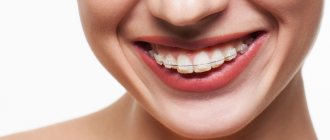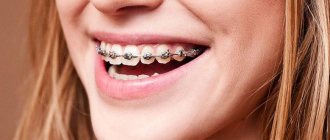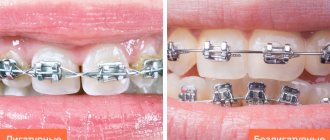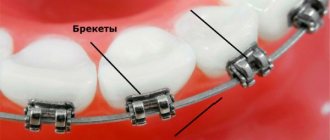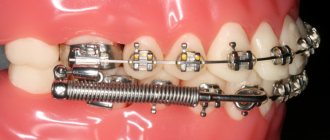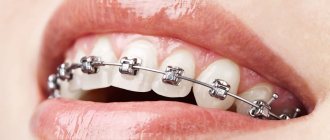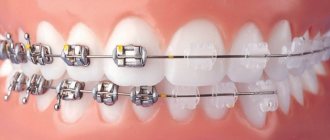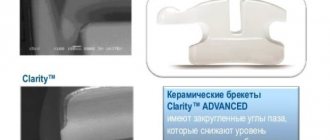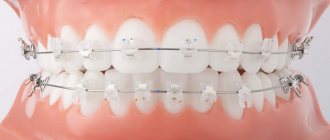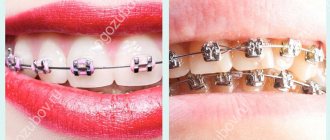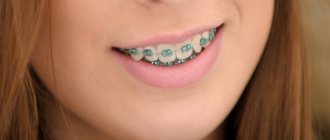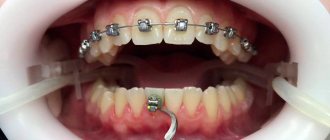In the last decade, physical activity has become one of the mandatory components of our lives. For some it helps to maintain health and youth, for others it is primarily valuable for social interaction with people of similar life interests, and still others seriously dream of Olympic medals. Therefore, orthodontists are often asked the question, “Can I play sports with braces?”
First of all, it should be noted that the increase in sports activity, generally speaking, has resulted in a noticeable increase in the incidence of dental injuries. Protective mouthguards, which became mandatory for professional football players in the USA back in 1962, and for hockey players in 1975, are used extremely rarely at the amateur level for unknown reasons in Russia. But the opportunity to make and wear a mouth guard with braces or on its own is offered by many orthodontic centers in the capital. Therefore, the correction of dentofacial defects in most cases is completely compatible with playing a variety of sports.
Professional sports and braces: compatibility of the incompatible
Statistics show that teeth, and therefore the braces on them, can be injured not only by doing boxing and martial arts or playing hockey, rugby, handball and American football. The list of potentially dangerous sports included skating, basketball, athletics and even tennis. But this did not stop world sports stars from correcting their dentition with orthodontic systems.
Tennis players Anna Kournikova, sisters Williams and Martina Hingis, and basketball stars David Robinson, Sam Bowie and Devon White have had their teeth fixed with braces. Even the famous Carl Lewis, an American track and field athlete who once received the title of the fastest man in the Universe, appeared in the photo wearing braces. When developing a treatment plan for them, orthodontists took into account the fairly high risk of injury to the face and jaws and selected the appropriate design option.
Need for increased hygiene
Food gets stuck on and between the braces and clings to the wires. If you eat outside the home, you need to be able to brush your teeth or at least rinse them thoroughly. Otherwise, smiling and even speaking is undesirable, because others don’t want to look at food particles stuck in your mouth. Opportunities for hygienic procedures are not available everywhere, and this introduces additional difficulties into the life of an ortho patient.
Positive point. Frequent hygiene and the habit of rinsing your teeth after eating are the prevention of caries. These are useful skills.
What kind of braces do we install?
- Installing a classic internal apparatus or innovative Incognito lingual braces allows you to maintain your usual training regimen. They are located on the inside of the jaws, do not injure the mucous membrane of the lips, cheeks and tongue and have proven themselves well in contact martial arts.
- If the bite is corrected by the vestibular apparatus, located externally and visible to others, the athlete will be offered a special orthodontic mouthguard with cells in which clasps glued to the teeth will be placed. It will not only protect braces and teeth from possible sports injuries, but will also protect the mucous membrane from injury by protruding elements of braces.
The main thing you need to know: the proper degree of protection will be provided only by an individually made mouthguard, and not by a standard, more affordable one.
Frequently asked questions about braces
— Does it hurt to get braces?
— It doesn’t hurt to install braces; the whole procedure takes place within an hour with the installation of braces on one jaw. The most unpleasant sensation in the procedure is that you cannot close your mouth. Painful sensations begin after we completely install the arch. The teeth are corrected under the action of the tension of the arch; the tooth begins to be pulled through the brace to the position to which the arch forces it to move. The arcs have the correct shape - a semicircle, parabola, or half-ellipse.
— Why do you need to correct your bite?
— The bite must be corrected in childhood in order for the child to eat properly, because the oral cavity is the first point in food processing. If a person “swallows” food, then problems with the gastrointestinal tract begin because of this. Also, incorrect position of the jaws can have a bad effect on the condition of the temporomandibular joint; it can hurt and cause complications in the form of headaches, difficulty opening the mouth, clicking and crunching in the joint. Also, an incorrect bite affects posture; the position of the head, due to the way our lower jaw is located in relation to the upper jaw, can change. This is a tilt of the head forward or backward. Plus, no one has canceled the aesthetic function - a beautiful smile is attractive and this is the first thing people pay attention to
—At what age is it better to correct teeth?
- Of course, it is better to start correcting teeth in childhood; from 6 to 11 years old we use orthodontic removable appliances - these are either individual plates or silicone appliances. It is possible to use a brace system from 8 to 11 years of age if there are indications for a partial brace system. The use of a full braces system begins at the age of 13-14, when the complete replacement of baby teeth with permanent ones has occurred and the teenager’s bite has already formed.
—How long does the treatment last?
— Treatment lasts for a year using removable devices, and for one and a half to two years when using braces.
—Do braces damage tooth enamel?
— Braces do not damage tooth enamel; poor oral hygiene does. Patients do not clean the soft plaque that accumulates around braces well enough, because of this, bacterial plaque begins to destroy the surface layer of enamel. Chalky spots and inflammatory reactions on the gums form - this is bleeding and swelling of the gums.
—I have a problem with braces, is there a more aesthetic option for straightening my teeth?
— Yes, in Estetik dentistry, the position of teeth can be corrected without using a brace system, but there are limited cases for this - a slight grouping, or minor changes in the bite. Such abnormalities can be corrected using progressive tooth alignment aligners. There is also an option for an aesthetic bracket system - these are sapphire or ceramic systems, and a white arch is selected to match the color of the teeth.
—How long does it take for a person to get used to braces?
— Each patient is individual, on average, addiction occurs in 3-4 days, for those who are especially sensitive, up to a week. Teeth begin to move and begin to wear out if a person eats hard food. Therefore, a gentle diet is recommended for the first 3-4 days. Subsequently, braces do not cause any discomfort.
—Do I need to wear anything else after wearing braces?
— After the bracket system is removed, a retention device is installed. This is a non-removable retainer strip on the inner surface of the six central teeth, it is permanently fixed to a special material, and a special tray is issued to the upper jaw, which maintains the result of the position of the teeth. Retention devices are worn from 5 to 10 years.
—Is it possible to have braces installed during pregnancy? How does pregnancy affect already installed braces? Will it be necessary to suspend treatment in such cases?
— During pregnancy, braces can be installed. This is not a contraindication; teeth will be more mobile due to changes in hormonal levels in women. Treatment is suspended in cases where there is a possibility of delivery through cesarean section and there is a need for general anesthesia. In these cases, you need to consult your obstetrician-gynecologist, and he will tell you about all the recommendations.
—What do you need to see an orthodontist? Should professional hygiene be carried out, and if so, how many days in advance?
— If the patient is an adult, a 3d-CBCT (cone-beam computed tomography) of the upper and lower jaw and TRG (teleradiography) lateral projection are required. If it’s a child, then a panoramic shot is enough. At the time of consultation, the teeth must be cured, professional hygiene must be carried out two weeks before installing the braces system.
Sign up now
By submitting data from the form, you consent to the processing of personal data in accordance with the personal data processing policy
An alternative option is the innovative Invisalign system.
Is it possible to do martial arts with braces?
In this case, Invisalign aligners may be a more suitable option. A mouth guard can be offered to athletes with less pronounced bite defects. It is made from a transparent elastic composite using a scanned image of the jaws and bite using IT technologies. The one-piece cast design allows for quick and effective tooth alignment and is an ideal choice for athletic patients.
Features of caring for braces
In order to minimize the possible risks of damage to the teeth and the braces themselves, it is necessary to adjust the diet in terms of eliminating products with a viscous consistency that can stick to the teeth and can complicate care, provoking the development of caries:
- sweet bakery products;
- confectionery products, sweets;
- chips, snacks, sweet sticks.
Solid food should be crushed to avoid increased stress on the structures when biting. It is recommended to completely avoid sugary carbonated drinks in order to prevent tooth demineralization.
In terms of hygiene, there is a standard list of care rules taking into account the types of braces installed:
- You need to brush your teeth regularly and be sure to do so after every meal;
- use special tactics for cleaning braces, since these are the critical areas;
- It is recommended to undergo professional cleaning once every two to three months;
- use special hygiene products: floss, orthodontic brushes, irrigators.
Using all of the above recommendations eliminates any possible harm from the use of braces and is guaranteed to preserve the health, attractiveness and flawlessness of your teeth.
Is it possible to practice boxing with braces?
With boxing the situation is more complicated. It's no secret that boxers traditionally enter the ring wearing special protective mouthguards. Therefore, theoretically, the medical Olympic reference book allows for the possibility of an athlete participating in competitions wearing braces. It is emphasized that the treating orthodontist must give his consent to this, and the jaws must be protected by a professionally made individual mouthguard that exactly matches the braces installed on the teeth.
In practice, each boxer must find the answer to this question himself, deciding what is more important for him at this stage - aesthetics or athletic achievements.
Positive effect on teeth
Of course, first of all, this is the correction and restoration of the bite. However, this process is very individual, and each case has its own characteristics.
Let's take a closer look at the main indications for wearing braces:
- all cases of pathological occlusion with varying degrees of deviation from the norm;
- spiral displacement of teeth, the so-called torsion;
- hyperdevelopment of one of the jaws;
- presence of gaps between teeth;
- abnormal arrangement of one or more teeth.
To summarize, we note that the main positive effect of installing braces is to correct the position of the teeth and return abnormal displacements to normal.
In any case, braces mean discomfort when eating. Do you really need braces as your doctor advises?
After all, the main issue lies not in diction, and not in problems with brushing your teeth. And the question is - are you ready to carry this pile of iron in the form of metal and ceramic braces in your mouth for the entire duration of treatment (a year or two)? Rub your tongue against them, polish them until they shine, constantly eliminating pieces of food? Braces when eating are uncomfortable and not aesthetically pleasing.
Consider treatment with aligners. There will be no problems at all when eating - food will not get stuck in them and your breath will not smell bad. The Star Smile company operates in more than 70 cities of Russia and will be able to offer you competent consultation with an orthodontist in your city. And the prices will pleasantly surprise you, because Star Smile has the lowest prices with excellent quality of treatment. Take the first step towards comfortable treatment.
When can diction change while wearing braces?
But! There is one correction. Sometimes, when a patient has a deep overlap, that is, the upper teeth overlap the lower teeth too much, the doctor installs onlays so that the patient does not simply mechanically knock down the lower braces with his upper teeth. These overlays come in different types: composite, cement, metal bite-sized braces. And they can be localized in different parts of the dentition: on the upper incisors (front teeth), on the canines, on the large molars. This all depends on the clinical situation and physician preference. In any case, this is all discussed in advance.
In the presence of such overlays, sometimes, if not very rarely, diction may suffer slightly. But, as practice shows, patients quickly get used to these pads and everything returns to normal. So if you are thinking about external braces and are worried about your diction, don’t worry, you can safely put this fear aside.
